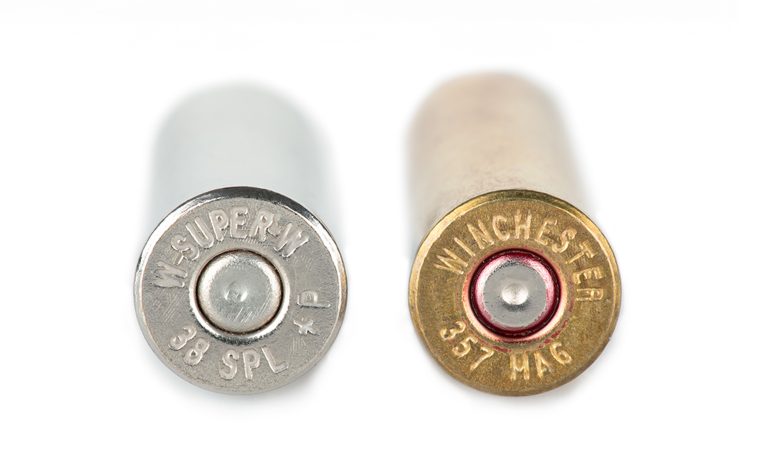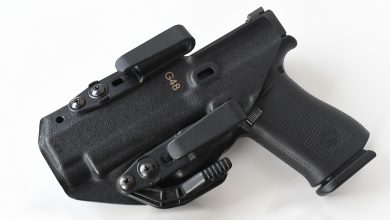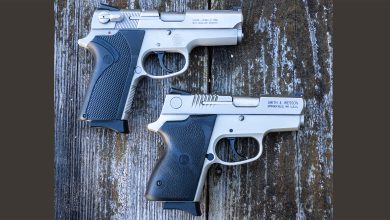Pistol with a Past

Light primer strikes may indicate that your Model 19 was used as a dedicated target gun. If you’d like to repurpose it as a self-defense piece or just an “all-arounder,” you’ll have to tighten the strain screw or otherwise increase mainspring tension.
I am happy and I am sad at the same time.
As I was perusing the show cases in my local gun shop recently, I came upon a revolver that I just had to have. The gun in question was a Smith & Wesson Model 19 with a 2.5-inch barrel in pristine condition. It apparently was an older model because of the pinned barrel and recessed charge holes in the cylinder, but it was stamped 19-4 inside of the gun, making me curious about the revolver’s age. The nickel finish made it pleasing to the eye and the round-butt grips fit my hands to a “T” when the shop owner let me handle the gun. What really sold the gun, other than its like-new condition, was the superb trigger in both double- and single-action. The gun had been well taken care of, being clean and lubricated right out of the original box that came with it. To say that I was a happy camper when I got home with my new gun would be an understatement.
Now for the sad part:
Within a few days I had time to make a trip to the range to shoot my new prize. I took some .357 Mag. rounds, some .38 Spl. +P loads and some wadcutters—all were factory-loaded ammunition—to the range for test firing. To my dismay, while trying to shoot double action, I experienced many light strikes. In single action, I encountered the same thing to a lesser degree, mainly with the more powerful ammunition. What would cause such a thing and what do I need to do to bring this pristine Model 19 to 100-percent reliability so I can carry it with confidence?
Linny Lever, Newport News, VA
Congratulations on finding this comparatively rare Model 19 revolver. Nickel models seem to be a favorite of Smith & Wesson collectors.
Without a letter from the factory, it would be an educated guess as to when this gun was made. By the process of elimination and validation from a former company employee, we can come close with the evidence you provided.
Model 19-4s were thought to have been made between 1977 and 1982. The pinned barrel ceased as a feature in Model 19 revolvers around 1982, as did the counter-bored charge holes in the cylinder. Elimination of the counter-bored charge holes was denoted as the Model 19-5, differentiating the -4 model from the -5 model.
The problem with light strikes, particularly with duty- or carry-type ammunition, would seem to indicate the previous owner liked to shoot recreationally as opposed to using it for self-defense. It has been a practice to loosen the strain screw on the mainspring (located at the bottom-front portion of the grip frame) until the gun would not fire target ammunition with the softest primers available, then turn the screw in a quarter to a half a turn, adding just enough tension to the mainspring to fire the ammunition with soft primer cups. This might be fine for a recreational gun, but is definitely not acceptable for a gun that might be used for personal defense or other serious purposes.
Simply tightening the strain screw and retesting the ammunition that would not fire initially may be the solution to your problem. (Keep in mind that increasing pressure on the mainspring with the strain screw will increase the trigger-pull weight.) If that does not help, remove the strain screw and inspect the end that contacts the mainspring. Some enterprising individuals, for reasons beyond me, will remove the screw and file down the end to shorten its length as opposed to simply backing out the screw a thread or two to serve the same purpose.
Since you already have the grips off the gun, inspect the mainspring for any file marks that may have been left to weaken the spring and lighten the trigger pull. If present, my recommendation to bring the revolver back to the capabilities expected of it would be to purchase a new mainspring and strain screw manufactured for your gun to ensure satisfactory function in the future.
As an afterthought, it might be prudent to look at the condition of the firing pin (located on the hammer of this generation revolver) to ensure its shape and integrity are consistent with one that will properly indent the primer of a chambered cartridge. It is rare but, on occasion, they get bent or damaged.
One of the caveats of buying a previously owned gun is that you rarely know what the previous owner or owners did to it, good or bad. While that may be the case, half the fun of buying a previously owned gun is going to the range and shooting it to find out. In the end, it’s a game of chance.
Read the full article here







